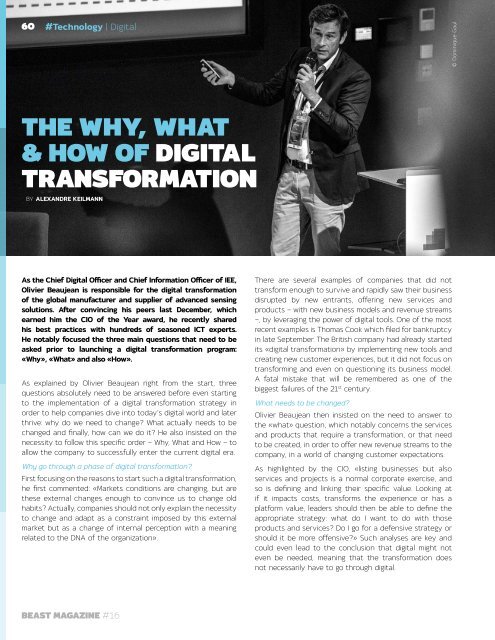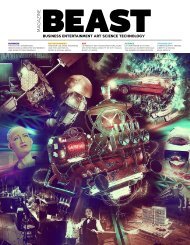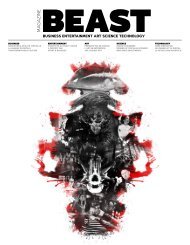Magazine BEAST #16 2019
You also want an ePaper? Increase the reach of your titles
YUMPU automatically turns print PDFs into web optimized ePapers that Google loves.
60 #Technology | Digital<br />
© Dominique Gaul<br />
THE WHY, WHAT<br />
& HOW OF DIGITAL<br />
TRANSFORMATION<br />
BY ALEXANDRE KEILMANN<br />
As the Chief Digital Officer and Chief Information Officer of IEE,<br />
Olivier Beaujean is responsible for the digital transformation<br />
of the global manufacturer and supplier of advanced sensing<br />
solutions. After convincing his peers last December, which<br />
earned him the CIO of the Year award, he recently shared<br />
his best practices with hundreds of seasoned ICT experts.<br />
He notably focused the three main questions that need to be<br />
asked prior to launching a digital transformation program:<br />
«Why», «What» and also «How».<br />
As explained by Olivier Beaujean right from the start, three<br />
questions absolutely need to be answered before even starting<br />
to the implementation of a digital transformation strategy in<br />
order to help companies dive into today’s digital world and later<br />
thrive: why do we need to change? What actually needs to be<br />
changed and finally, how can we do it? He also insisted on the<br />
necessity to follow this specific order – Why, What and How – to<br />
allow the company to successfully enter the current digital era.<br />
Why go through a phase of digital transformation?<br />
First focusing on the reasons to start such a digital transformation,<br />
he first commented: «Markets conditions are changing, but are<br />
these external changes enough to convince us to change old<br />
habits? Actually, companies should not only explain the necessity<br />
to change and adapt as a constraint imposed by this external<br />
market but as a change of internal perception with a meaning<br />
related to the DNA of the organization».<br />
There are several examples of companies that did not<br />
transform enough to survive and rapidly saw their business<br />
disrupted by new entrants, offering new services and<br />
products – with new business models and revenue streams<br />
–, by leveraging the power of digital tools. One of the most<br />
recent examples is Thomas Cook which filed for bankruptcy<br />
in late September. The British company had already started<br />
its «digital transformation» by implementing new tools and<br />
creating new customer experiences, but it did not focus on<br />
transforming and even on questioning its business model.<br />
A fatal mistake that will be remembered as one of the<br />
biggest failures of the 21 st century.<br />
What needs to be changed?<br />
Olivier Beaujean then insisted on the need to answer to<br />
the «what» question, which notably concerns the services<br />
and products that require a transformation, or that need<br />
to be created, in order to offer new revenue streams to the<br />
company, in a world of changing customer expectations.<br />
As highlighted by the CIO, «listing businesses but also<br />
services and projects is a normal corporate exercise, and<br />
so is defining and linking their specific value. Looking at<br />
if it impacts costs, transforms the experience or has a<br />
platform value, leaders should then be able to define the<br />
appropriate strategy: what do I want to do with those<br />
products and services? Do I go for a defensive strategy or<br />
should it be more offensive?» Such analyses are key and<br />
could even lead to the conclusion that digital might not<br />
even be needed, meaning that the transformation does<br />
not necessarily have to go through digital.<br />
<strong>BEAST</strong> MAGAZINE <strong>#16</strong>

















